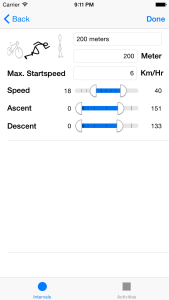 This view shows the definitions of the intervals you want to track. You can create your own or delete/mofiy existing ones.
This view shows the definitions of the intervals you want to track. You can create your own or delete/mofiy existing ones.
Some background info
HIITList searches for intervals in tracks.Not just any interval : you are probably not intrested in every slightly faster 16 meter segment of yesterdays warming-up. But you do want to know how you did these 6 sprints – 100 meter each – that came after that warming up.
That is were interval definitions come into play. With interval definitions, you instruct HIITList which interval you want to track and compare. An interval definition is defined by
- An activity type (running, cycling, swimming).
- A name
- A length. You do not want to compare apples to oranges but 60 meters sprints to 60 meter sprints.
- A minimum speed. The fastest 200 meter during your warmin up is not what you want to track (you could). Only the real HIITS. And these are faster than this minumum speed. Everything below is not considered as HIIT.
- Minimum start speed. You should not compare the last 60 meters of a 100 meter race with a 60 meter sprint. Standing or flying starts make a huge difference. To define a standing start interval, 6 km/hr as minimum start speed is probably a good value. Usain Bolt should set it to 9 or even 10 km/hr. 6 km/hr translates to 1.6 meters covered during the first second of an interval.
- Mimimum and maximum descent : downhill intervals should not be compared to intervals on a flat track. Do not use (=set large values) if your GPS device does not have a barometric altimeter. GPS altimeter data is worthless.
- Minimum and maximum ascent. Uphill intervals should not be compared to intervals on a flat track. Do not use (=set large values) if your GPS device does not have a barometric altimeter. GPS altimeter data is worthless.
To Create a new interval definition…
…you tap ‘+’. This opens the interval denition view. Here you can set the interval properti es. Just a few extra notes
es. Just a few extra notes
- You select the activity type (running, cycling, swimming…) using the type selection carrousel. Just drag the icon to the right or the left to select the next type.
- To fine tune the speed or the ascent,descent, you can tap the lower number (lowers the minimum value one step – 0.5 km/hr for speed, 1 meter for ascent/descent) or the higher number (increments the upper value with one step).
- The speed sliders are linear, the ascent and descent sliders are logarithmic. Just move them around to a feeling of what that means.
- If your GPS device does not have a barometric altimeter, enter 0 as minimum and more than 20 as maximum ascent/descent. Some trees next to the training track are enough to make GPS-height flip by over 10 meters.
To modify an interval definition
Press the pencil button on the row you want to modify. After you modify a definition, all training sessions will be rescanned.
To delete an interval definition
Drag it to the left and tap ‘Delete’. All intervals found will be deleted with its definition.